I grew up part of a fishing family and the passion for fishing was instilled into me from birth.
Fishing has broadened my horizons as I’ve travelled around the country, learning different techniques, catching new species and meeting new people. The knowledge I’ve acquired has been no burden: Patience, etiquette, responsibility and manners are some of the better traits a young person can gain toting a fishing pole.
I still thank my Mum and Dad for exposing me to such a wonderful, satisfying and fruitful sport and now, with three kids of my own, I feel a moral obligation to pass on that same passion.
My three whippersnappers have slowed my spontaneous fishing sessions but they’ve created planned fishing outings which form the basis of some great family adventures.
Fishing with a young tribe is very achievable.
Sure, it’s triple the tangles, hooks flinging in every direction and the tackle box is constantly up-ended and emptied, but it’s fun.
When you witness your own child fight and land their first fish, it’s something only you will appreciate and understand.
I have new problems, like my soft plastics being cut in half when I leave my braid scissors out. I watch in tears as my expensive hardbody lures drift away after being catapulted across the river, and – tangles! Don’t even go there!
All in all, it’s still very fun –hard work, but fun.
Involve your kids in all aspects of the day’s activities and, above all, be the best role model you can.
If you lose patience, then so will they. Little ones watch very closely and pick up on every detail.
Whether you’re shore-based or fishing from a boat or canoe, you must check the weather. You’ll turn kids off fishing quickly if the wind is too strong or if it pours rain.
Weather can turn ugly at the drop of a hat and you could be flirting with serious danger. Your kids’ lives are in your hands. Listen to the forecasts or visit websites to obtain an accurate weather report and never ignore a forecast and make your own assumptions.
It’s also a good idea to check the tides. I try to fish the neap tides, around the first and last quarters of the moon. I find the fishing good and it’s easier for the kids to keep their lines in the water, rather than being washed back up along the shore or floating to the surface in the stronger tidal flow.
If you intend to gather your own fresh bait, plan it so the kids can participate. Gathering the bait can be more fun than fishing itself!
Whether it is pumping nippers, catching beach worms or crabs, or maybe trapping poddy mullet, there is a barrel of fun to be had. Besides, the kids learn and appreciate things more when they’re involved.
Always pack enough food and water. It’s amazing how you can break a kid’s boredom waiting for a bite by letting them open a packet of chips or peel a banana. My favourite is giving them a box of sultanas; the whole time they’re plucking sultanas out of the box one-by-one, they’re not yelling and screaming at each other.
You could also take a break from fishing with a walk or a swim. Buying lunch or an ice cream can make the whole outing more inviting for your children. Plan the trip so your location is handy to some shops.
Make it fun and the kids will love it.
Above all, try not to be out all day. Limit your fishing to two or three hours to avoid the kids getting bored. If they get sick of fishing they’ll be reluctant to go with you next time and, no, that’s not the plan!
Right from the get-go, talk to your kids, let them know your plan and give them their own little roles to play, like carrying the rods or a bait bucket – kids get a kick out of helping.
If gathering bait, let them have a crack at it. It can be very satisfying to see them pumping pink nippers on the sand flats ... and very funny, too!
If they can’t tie their own knots, show them how. Involve them right through the process of rigging up.
Let them hold the terminal tackle (swivels, sinkers, hooks). Explain the dangers of sharp hooks and show them how a hook works.
Kids love to bait their own hooks, so let them. Guide them in a fashion so you’re not taking the job out of their hands.
Casting can be frustrating but keep your cool and teach them all the steps in an order that’s easy to remember.
Don’t be disheartened if their casting isn’t on the money, these things take time and there’s nothing like practice.
Encourage them as much as you can. Most of the time, kids would rather practise casting than fish.
When they hook a fish, please don’t snatch the rod and land the fish yourself. I’ve seen way too many heartbroken kids after their overexcited parent has ripped the rod out of their hands. Let the kids have their fun.
It’s almost impossible for you to fish while you’re looking after your kids. Sacrifice your own fishing so you can maximise your kids’ chances.
If you can manage to wet a line, any hooked fish should be passed to your kids to reel in. It will mean the world to them.
With extreme caution and constant supervision, lures can give kids ample opportunity to practise casting and there’s no time wasted baiting up.
My young bloke, Clayton, caught his first bream on a Jackall TN50. While fishing from our local wharf, Clay asked me, “Dad, what’s that funny looking thing in your tackle box?” He was ecstatic when he was permitted to use one of Dad’s lures.
It was nice to watch the little Jackall descend in the clear water and it was truly amazing when it was crunched by a 26cm bream! It was a special moment for father and son.
My eldest daughter, Calissa, has taken to soft plastics and is chalking up some great captures.
Let your kids interact with the fish, whether it’s a whopper or small fry. They don’t all have to be monsters; small bream and blackfish provide just as much fun for the kids legal fish.
Teach them how to handle fish correctly and let them study their catch.
I never let my kids on the water without a suitable personal flotation device (PFD) and new laws mean every child under 12 on a boat less than 4.8m long must wear one at all times.
It can pay to fit a PFD even when shore-based, especially around steep banks, high jetties, strong current and cold water.
A basic first aid kit is also handy.
Be vigilant in applying sunblock, a good sun hat and UV protective clothing.
It’s advisable to crush the barbs down on all hooks. My 2-year-old son had a hospital visit to have a set of trebles removed from his lip after I stupidly left a tackle box open.
The easiest fish to target in an estuary is the mullet. They can easily be attracted by a berley trail of finely mashed wetted stale bread and can be caught on peeled prawns, fresh bread balls or dough.
Every system holds them and they can be targeted from a wharf, sand flat, rock wall or boat. Mullet fight hard, are kid friendly, tasty to eat and good bait.
I prefer the beginning of the run-out tide in my local estuary.
Rigging couldn’t be simpler: Cover the barb of a No 6 long-shank hook directly tied to main line around 6lb. Rod and reel or a handline work.
You could add a split-shot sinker to hold the bait under the surface and aid in casting.
Most of the time, you’ll be able to berley mullet right to your boat or to your feet.
If the mullet are wary, attach a small float to the line to help carry the bait away. Watching a float can be a fun way to spot bites, too.
Taking a feed of fish home for the table is great but it’s also good to teach youngsters responsible fishing. Observing size and bag limits, avoiding no-go park zones and catch and release.
Putting fish back for next time is really special and photos will provide memories forever.
Our sport lies firmly in the grasp of our children, so teaching them responsibilities at a tender age will ensure there’ll be a fish around for their kids to catch, too.
Facts
CHILD’S PLAY
• Keep tackle and techniques simple
• Make your children’s safety your top priority
• Break up the fishing with other fun activities
• Keep your cool and be a good role model
• Involve your children in every activity
• Teach them responsibilities and good etiquette
• Plan your fishing to maximise your kids’ chances of catching fish, even small ones
• Above all, have fun and enjoy your children’s company. They’re cool little people!

Clay Badullovich studies his first lure-caught bream. The fish was released, as Clay found the lure more fascinating than the fish.

Calissa Badullovich, who loves using soft plastics, proudly displays one of the flounder she caught in a fishing competition.
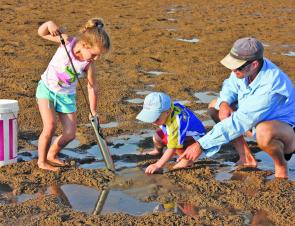
Getting the kids involved in gathering the bait can be just as much fun as fishing itself.
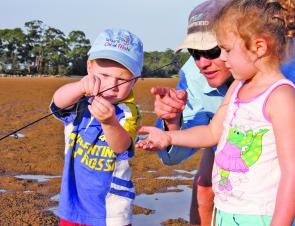
Take the time to let your kids try rigging their own lines. Calissa holds the terminal tackle while brother Clay runs the line through the guides.

They’re never too young to learn lure fishing. The author’s nephew, Johnny, was over the moon when he caught his first snapper on a plastic.
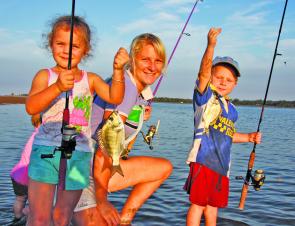
Fishing can be fun for the whole family. Get Mum involved, too.
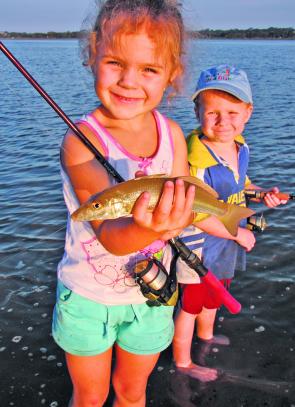
The sand flats are great locations to introduce kids to fishing. They are kid-friendly and can produce some tasty meals like this sand whiting.
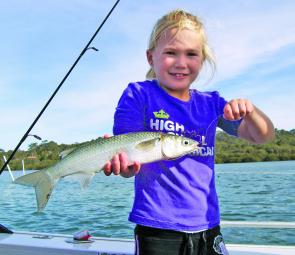
The easiest way to get a child’s rod bending is to berley up some mullet. Nicola Badullovich had a ball reeling in this cracker.

Teach your kids to handle fish correctly. Note how Clay is cradling the stomach of his flathead prior to release.




